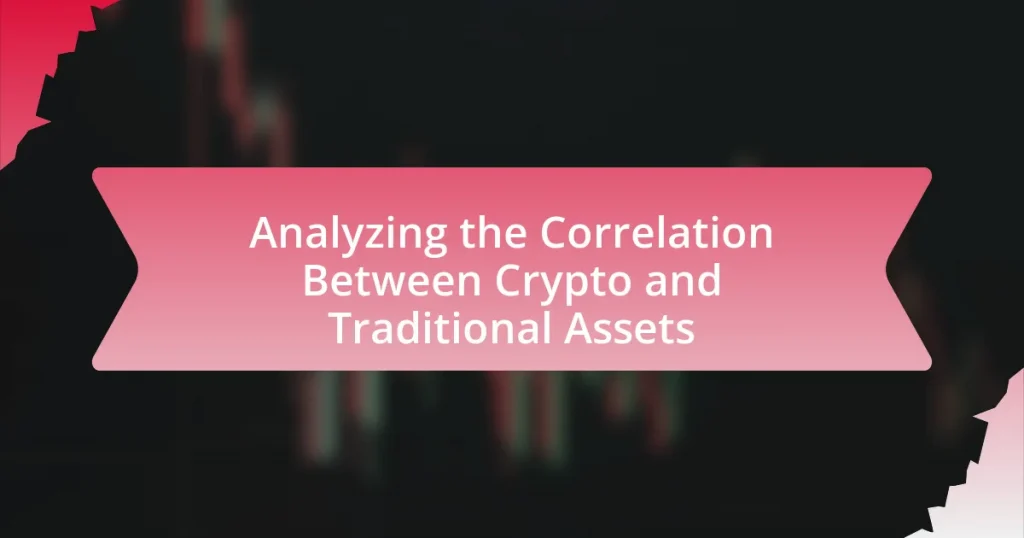The article analyzes the correlation between cryptocurrencies and traditional assets, highlighting their generally low correlation and the implications for investors. It discusses how crypto assets differ from traditional assets in terms of decentralization, volatility, and regulatory frameworks. Key factors influencing correlation, such as market sentiment, economic indicators, and external events, are examined, along with the methods and statistical tools used for correlation analysis. The article emphasizes the importance of understanding these correlations for effective portfolio diversification and risk management strategies, while also addressing common misconceptions and best practices for investors.

What is the correlation between crypto and traditional assets?
The correlation between crypto and traditional assets is generally low, indicating that they do not move in tandem. Research conducted by the University of Cambridge in 2021 found that Bitcoin’s correlation with the S&P 500 was around 0.2, suggesting minimal relationship. Additionally, during market downturns, cryptocurrencies often behave independently of traditional assets, as evidenced by the 2020 market crash where Bitcoin and stocks reacted differently. This low correlation can provide diversification benefits for investors looking to balance their portfolios.
How do crypto assets differ from traditional assets?
Crypto assets differ from traditional assets primarily in their digital nature and decentralized structure. Unlike traditional assets such as stocks or real estate, which are typically regulated and managed by centralized entities, crypto assets operate on blockchain technology, allowing for peer-to-peer transactions without intermediaries. This decentralization enhances security and transparency, as transactions are recorded on a public ledger. Additionally, crypto assets are highly volatile, with price fluctuations often driven by market sentiment and speculation, contrasting with the more stable valuations of traditional assets. For instance, Bitcoin’s price has experienced swings of over 10% in a single day, highlighting its volatility compared to the relatively stable performance of traditional equities.
What are the defining characteristics of crypto assets?
Crypto assets are defined by their decentralized nature, digital form, and reliance on blockchain technology. These assets operate independently of central authorities, allowing for peer-to-peer transactions that enhance security and transparency. The use of cryptographic techniques ensures the integrity and authenticity of transactions, while the limited supply of many cryptocurrencies, such as Bitcoin, introduces scarcity, which can influence value. Additionally, crypto assets are highly volatile, often experiencing significant price fluctuations, which can be attributed to market sentiment and regulatory developments. These characteristics distinguish crypto assets from traditional financial instruments, highlighting their unique role in the evolving financial landscape.
What are the defining characteristics of traditional assets?
Traditional assets are typically characterized by their physical presence, established market structures, and historical performance. These assets include real estate, stocks, bonds, and commodities, which have been traded for decades or centuries. Their value is often derived from tangible factors such as cash flow, intrinsic worth, and market demand. For instance, real estate generates rental income, while stocks represent ownership in companies with earnings potential. Additionally, traditional assets are usually regulated by government entities, providing a level of security and transparency that is often absent in newer asset classes like cryptocurrencies. This regulatory framework contributes to their stability and predictability in investment returns.
Why is it important to analyze the correlation?
Analyzing the correlation is important because it helps investors understand the relationship between different asset classes, such as cryptocurrencies and traditional assets. This understanding enables investors to make informed decisions regarding portfolio diversification, risk management, and potential returns. For instance, research has shown that during market downturns, cryptocurrencies often exhibit different correlation patterns compared to traditional assets like stocks and bonds, which can influence investment strategies. By analyzing these correlations, investors can optimize their asset allocation to mitigate risks and enhance overall portfolio performance.
What implications does the correlation have for investors?
The correlation between crypto and traditional assets implies that investors can diversify their portfolios to manage risk more effectively. When cryptocurrencies exhibit a strong correlation with traditional assets, such as stocks or bonds, it indicates that market movements may affect both asset classes similarly. For instance, during economic downturns, if both asset classes decline together, investors may face amplified losses. Conversely, if the correlation weakens, investors might benefit from reduced risk exposure, as crypto could act as a hedge against traditional market volatility. Historical data shows that in 2020, Bitcoin’s correlation with the S&P 500 increased significantly, suggesting that investors should closely monitor these relationships to make informed decisions.
How can understanding the correlation influence investment strategies?
Understanding the correlation between assets can significantly influence investment strategies by enabling investors to optimize their portfolios for risk and return. When investors recognize how different assets, such as cryptocurrencies and traditional stocks, move in relation to one another, they can make informed decisions about asset allocation. For example, if historical data shows that cryptocurrencies tend to rise when traditional markets fall, an investor might allocate a portion of their portfolio to crypto as a hedge against market downturns. This strategic allocation can enhance returns while mitigating risk, as evidenced by studies indicating that diversified portfolios with negatively correlated assets often outperform those with positively correlated assets.
What methods are used to analyze the correlation?
Statistical methods are primarily used to analyze the correlation between crypto and traditional assets. Common techniques include Pearson correlation coefficient, Spearman’s rank correlation, and Kendall’s tau, which quantify the strength and direction of relationships between asset returns. For instance, the Pearson correlation coefficient measures linear relationships, while Spearman’s and Kendall’s methods assess monotonic relationships, providing insights into how these asset classes move in relation to one another. These methods are validated by their widespread application in financial studies, demonstrating their effectiveness in revealing correlations in asset performance.
What statistical tools are commonly employed in correlation analysis?
Statistical tools commonly employed in correlation analysis include Pearson correlation coefficient, Spearman’s rank correlation coefficient, and Kendall’s tau coefficient. The Pearson correlation coefficient measures the linear relationship between two continuous variables, while Spearman’s rank correlation assesses the strength and direction of the association between two ranked variables. Kendall’s tau coefficient evaluates the ordinal association between two variables, providing a measure of correlation that is less sensitive to outliers. These tools are widely used in various fields, including finance, to analyze relationships between assets, such as cryptocurrencies and traditional investments.
How do historical data and trends play a role in this analysis?
Historical data and trends are crucial in analyzing the correlation between crypto and traditional assets as they provide a foundation for understanding past behaviors and market dynamics. By examining historical price movements, trading volumes, and market sentiment, analysts can identify patterns that may predict future correlations. For instance, during the 2020 market downturn, Bitcoin’s price movements were closely monitored alongside traditional assets like stocks, revealing a temporary correlation that suggested a flight to liquidity. This analysis is supported by data from sources such as CoinMarketCap and financial market reports, which illustrate how historical events, like the 2008 financial crisis, influenced investor behavior across asset classes.

What factors influence the correlation between crypto and traditional assets?
The correlation between crypto and traditional assets is influenced by factors such as market sentiment, regulatory developments, macroeconomic indicators, and technological advancements. Market sentiment drives investor behavior, often leading to simultaneous movements in both asset classes during periods of optimism or fear. Regulatory developments, such as government policies on cryptocurrency, can significantly impact investor confidence and market dynamics. Macroeconomic indicators, including inflation rates and interest rates, affect the attractiveness of both crypto and traditional assets, as investors seek to hedge against economic uncertainty. Technological advancements in blockchain and financial systems can also create new investment opportunities, altering the relationship between these asset classes.
How do market conditions affect the correlation?
Market conditions significantly influence the correlation between crypto and traditional assets. During periods of economic uncertainty, such as recessions or financial crises, correlations tend to increase as investors seek safe-haven assets, leading to a stronger relationship between asset classes. For example, during the 2008 financial crisis, correlations between various asset classes, including cryptocurrencies and equities, rose as market participants reacted similarly to adverse conditions. Conversely, in stable or bullish market conditions, correlations may weaken as investors diversify their portfolios, allowing crypto assets to behave independently from traditional markets. This dynamic is evidenced by the varying correlation coefficients observed in different market phases, highlighting the impact of prevailing economic conditions on asset interrelationships.
What role does market volatility play in the relationship?
Market volatility significantly influences the relationship between crypto and traditional assets by affecting investor behavior and asset correlation. High volatility in the cryptocurrency market often leads to increased risk perception among investors, prompting them to seek safer traditional assets, thereby creating a negative correlation during turbulent periods. For instance, during the market crash of March 2020, Bitcoin’s price dropped sharply while gold, a traditional asset, saw increased demand as a safe haven, illustrating this inverse relationship. Conversely, when market conditions stabilize, cryptocurrencies may exhibit positive correlation with traditional assets as investors regain confidence, as seen in the recovery phases following market downturns.
How do economic indicators impact the correlation?
Economic indicators significantly influence the correlation between crypto and traditional assets by providing insights into market conditions and investor sentiment. For instance, when economic indicators such as GDP growth, unemployment rates, or inflation show positive trends, traditional assets like stocks may perform well, leading to increased investor confidence. This confidence can spill over into the cryptocurrency market, potentially increasing correlation as investors diversify into crypto. Conversely, negative economic indicators can lead to risk aversion, causing both traditional assets and cryptocurrencies to move in tandem as investors seek safe havens or liquidate positions. Historical data supports this, as during economic downturns, correlations between Bitcoin and traditional assets like gold have increased, indicating a shift in investor behavior in response to economic signals.
What external events can alter the correlation?
External events that can alter the correlation between crypto and traditional assets include regulatory changes, macroeconomic shifts, and geopolitical tensions. Regulatory changes, such as new laws or restrictions on cryptocurrency trading, can significantly impact investor sentiment and market dynamics, leading to a shift in correlation. For example, the announcement of stricter regulations in major markets like the United States or the European Union can cause cryptocurrencies to decouple from traditional assets like stocks or bonds. Macroeconomic shifts, such as changes in interest rates or inflation rates, can also influence correlations; for instance, rising inflation may lead investors to seek alternative assets, including cryptocurrencies, thus altering their relationship with traditional assets. Additionally, geopolitical tensions, such as conflicts or trade wars, can drive investors to react differently to crypto and traditional assets, further affecting their correlation.
How do regulatory changes influence the relationship?
Regulatory changes significantly influence the relationship between cryptocurrency and traditional assets by altering market dynamics and investor behavior. For instance, when governments implement stricter regulations on cryptocurrencies, it can lead to increased volatility in crypto markets, as seen in 2017 when China banned initial coin offerings, causing a sharp decline in crypto prices. Conversely, regulatory clarity, such as the U.S. Securities and Exchange Commission’s guidance on digital assets, can enhance investor confidence and lead to greater integration of cryptocurrencies into traditional financial systems. This interplay demonstrates that regulatory frameworks can either foster or hinder the correlation between these asset classes, impacting investment strategies and market stability.
What impact do technological advancements have on the correlation?
Technological advancements significantly enhance the correlation between cryptocurrency and traditional assets by improving market accessibility and data analysis. For instance, the development of blockchain technology facilitates real-time transactions and transparency, which increases investor confidence and participation in both markets. Additionally, advancements in algorithmic trading and artificial intelligence enable more sophisticated analysis of market trends, leading to a more integrated trading environment. Research indicates that as technology evolves, the correlation coefficients between cryptocurrencies and traditional assets, such as stocks and bonds, tend to increase, reflecting a growing interdependence driven by shared technological infrastructure and investor behavior.
How do investor behaviors shape the correlation?
Investor behaviors significantly shape the correlation between crypto and traditional assets by influencing market dynamics through trading patterns, sentiment, and risk appetite. For instance, when investors exhibit high risk tolerance, they may allocate more capital to cryptocurrencies, leading to increased price volatility and a stronger correlation with traditional assets during market shifts. Research by the CFA Institute indicates that during periods of economic uncertainty, investor flight to safety can cause traditional assets like gold to rise while cryptocurrencies may either decouple or follow suit, depending on investor sentiment. This interplay demonstrates how collective investor actions can create or diminish correlations between asset classes.
What psychological factors influence investor decisions in crypto and traditional markets?
Psychological factors influencing investor decisions in both crypto and traditional markets include cognitive biases, emotional responses, and social influences. Cognitive biases such as overconfidence can lead investors to underestimate risks, while loss aversion may cause them to hold onto losing investments longer than advisable. Emotional responses, particularly fear and greed, significantly impact decision-making; for instance, fear of missing out (FOMO) can drive rapid investment in volatile assets like cryptocurrencies. Social influences, including herd behavior, often result in investors following trends rather than conducting independent analysis. Research by Barberis and Thaler (2003) highlights how these psychological factors can lead to market anomalies, demonstrating their relevance in both market contexts.
How does the diversification strategy affect the correlation?
A diversification strategy reduces the correlation between assets in a portfolio. By including a mix of asset classes, such as cryptocurrencies and traditional assets like stocks and bonds, investors can mitigate risks associated with market volatility. For instance, during economic downturns, traditional assets may perform poorly while cryptocurrencies might remain stable or even appreciate, leading to lower overall portfolio correlation. Research indicates that portfolios with a diversified mix of assets can achieve a correlation coefficient closer to zero, indicating less relationship between asset movements, which enhances risk-adjusted returns.

What are the practical implications of the correlation analysis?
The practical implications of correlation analysis in the context of analyzing the correlation between crypto and traditional assets include informed investment decisions and risk management strategies. By understanding the degree to which these asset classes move in relation to one another, investors can optimize their portfolios, balancing potential returns against risks. For instance, if a strong negative correlation is identified, investors may choose to hedge their positions in traditional assets with crypto investments to mitigate losses during market downturns. Additionally, correlation analysis can guide asset allocation, helping investors diversify their holdings effectively. Historical data shows that during certain market conditions, cryptocurrencies have exhibited low correlation with traditional assets, suggesting potential benefits for portfolio diversification.
How can investors leverage the correlation for better decision-making?
Investors can leverage the correlation between crypto and traditional assets to enhance decision-making by diversifying their portfolios based on the observed relationships. For instance, if historical data indicates that cryptocurrencies tend to move in tandem with certain traditional assets during specific market conditions, investors can adjust their asset allocation to mitigate risk or capitalize on potential gains. Research by the University of Cambridge shows that during market downturns, cryptocurrencies often exhibit lower correlation with traditional equities, suggesting that including crypto can provide a hedge against stock market volatility. By analyzing these correlations, investors can make informed decisions that align with their risk tolerance and investment goals.
What strategies can be employed based on correlation insights?
Strategies that can be employed based on correlation insights include portfolio diversification, risk management, and asset allocation adjustments. Portfolio diversification involves spreading investments across both crypto and traditional assets to mitigate risk, as correlations can indicate how these asset classes move in relation to each other. For instance, if crypto assets show a low correlation with traditional stocks, investors can reduce overall portfolio volatility by including both asset types. Risk management strategies can be enhanced by using correlation insights to identify potential hedging opportunities; for example, if a downturn in traditional markets correlates with a rise in crypto, investors may allocate more to crypto during such periods. Additionally, asset allocation adjustments can be made based on changing correlation dynamics; if the correlation between crypto and traditional assets increases, investors might reconsider their exposure to either asset class to optimize returns.
How can risk management be enhanced through correlation analysis?
Risk management can be enhanced through correlation analysis by identifying relationships between different asset classes, which allows for better diversification and risk mitigation strategies. Correlation analysis quantifies how asset prices move in relation to one another, enabling investors to understand potential risks associated with their portfolios. For instance, if cryptocurrencies exhibit a low or negative correlation with traditional assets like stocks or bonds, incorporating them into a portfolio can reduce overall volatility and enhance returns. Historical data shows that during market downturns, certain assets may behave differently, thus providing insights into how to allocate resources effectively to minimize risk.
What are the common pitfalls in interpreting the correlation?
Common pitfalls in interpreting correlation include confusing correlation with causation, overlooking the impact of confounding variables, and failing to consider the context of the data. Correlation does not imply that one variable causes changes in another; for instance, a strong correlation between cryptocurrency prices and stock market performance does not mean that one influences the other. Additionally, confounding variables, such as market sentiment or regulatory changes, can distort the perceived relationship between two assets. Lastly, without understanding the broader economic context, such as market cycles or geopolitical events, interpretations of correlation can lead to misleading conclusions.
What misconceptions exist regarding the relationship between crypto and traditional assets?
One major misconception regarding the relationship between crypto and traditional assets is that cryptocurrencies are entirely uncorrelated with traditional financial markets. In reality, studies have shown that cryptocurrencies, particularly Bitcoin, exhibit varying degrees of correlation with traditional assets like stocks and commodities, especially during periods of market stress. For instance, research by the University of Cambridge indicates that Bitcoin’s correlation with the S&P 500 increased significantly during the COVID-19 pandemic, suggesting that crypto can behave similarly to traditional assets in times of economic uncertainty. This challenges the perception of cryptocurrencies as completely independent investment vehicles.
How can over-reliance on correlation analysis lead to poor investment choices?
Over-reliance on correlation analysis can lead to poor investment choices by creating a false sense of security regarding asset performance. Investors may assume that a strong correlation between two assets indicates a predictable relationship, neglecting other critical factors such as market conditions, economic indicators, and individual asset fundamentals. For instance, during the 2008 financial crisis, many investors relied on historical correlations between real estate and stock markets, which failed to predict the drastic downturns in both sectors, leading to significant losses. This demonstrates that correlation does not imply causation, and relying solely on it can result in misguided investment strategies.
What best practices should investors follow when analyzing correlation?
Investors should utilize statistical methods, such as Pearson correlation coefficients, to accurately analyze the correlation between crypto and traditional assets. This quantitative approach allows investors to measure the strength and direction of the relationship between asset classes. Additionally, investors should consider the time frame of the data being analyzed, as correlations can vary significantly over different periods; for instance, a study by the CFA Institute found that correlations between Bitcoin and traditional equities increased during market downturns, indicating a shift in investor behavior. Furthermore, investors should account for external factors, such as macroeconomic indicators and regulatory changes, which can influence correlation dynamics. By applying these best practices, investors can make more informed decisions regarding asset allocation and risk management.
How can continuous monitoring improve investment outcomes?
Continuous monitoring can improve investment outcomes by enabling timely adjustments to portfolios based on real-time market data and trends. This proactive approach allows investors to respond quickly to market fluctuations, reducing potential losses and capitalizing on emerging opportunities. For instance, a study by the CFA Institute found that investors who actively monitor their investments can achieve returns that are 1.5% higher annually compared to those who do not. By integrating continuous monitoring, investors can enhance their decision-making processes, leading to more informed and strategic investment choices.
What resources are available for ongoing correlation analysis?
Resources available for ongoing correlation analysis include statistical software, financial databases, and analytical tools. Statistical software such as R and Python libraries (e.g., Pandas, NumPy) provide functionalities for calculating correlation coefficients and visualizing data trends. Financial databases like Bloomberg and Yahoo Finance offer access to historical price data for both crypto and traditional assets, enabling comprehensive analysis. Additionally, platforms like CoinMarketCap and CoinGecko provide real-time data on cryptocurrency prices, which can be correlated with traditional asset performance. These resources facilitate accurate and timely correlation analysis, essential for understanding market dynamics.















